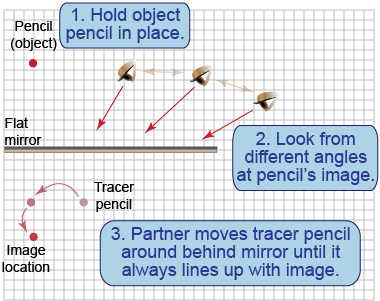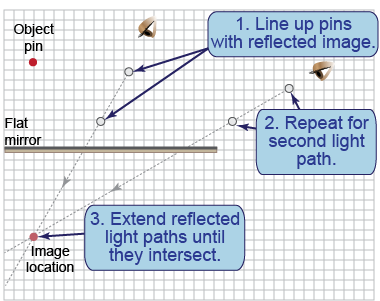|
| Essential questions | | How and where does an image form in a mirror? | |
|
If you look at yourself in a mirror, where is your image located? In this investigation, you will use three different techniques for locating the image produced by a flat mirror. 
|
Part 1: Locate the image using parallax

- Mount a flat mirror vertically on top of a piece of graph paper and trace its location.
- Hold a tall “object” pencil near the shiny side of the mirror. Mark its location.
- Move a second “tracer” pencil behind the mirror until it lines up with the reflection of the “object” pencil for every angle you look in the mirror.
- What does the location of the tracer pencil signify?
- Measure the distance from the mirror to the object and from the mirror to the image. Which is larger, or are these distances the same?

 |
Parallax
Parallax is when the direction of an object appears to be different depending on your viewing position. In this activity, you are minimizing the parallax between the reflected image of the “object” pencil and the “tracer” pencil. 
|
Part 2: Locate the image using pins

- Replace the “object” pencil with a pin.
- Look at the image of the pin and place two pins in the graph paper in line with this image.
- Move sideways and repeat with two more pins.
- Draw lines connecting each pair of pins to each other; extend these lines until they intersect.
- What does each of the two lines represent?
- Predict where the image will be located and why.
- Does your image location agree with the location from Part 1? Was your prediction correct?

Part 3: Trace the rays using a laser pointer and index card
Caution: never look directly at a laser. - Mount a laser pointer horizontally using a ring stand and a 90° rod clamp. Align the laser to point through the object pin and strike the mirror at an angle.
- Use the edge of an index card to locate and trace the path of the laser light (incident and reflected) directly onto the graph paper.
- Position the laser at a different angle to the mirror and trace the new path.
- Label the incident and reflected rays. Do the rays obey the law of reflection?
- How can you find the image using the light paths you made?
- Compare the laser pointer method to the other two. Which is better? Why?

 |
Going further: Locate the image using a compass
 Here is a bonus method using a geometry technique you may have learned in math class!
Here is a bonus method using a geometry technique you may have learned in math class! - Place the sharp end of the compass on your “object” location. Draw two arcs that intersect with the surface of the mirror.
- Place the sharp end of the compass on one of these intersections and draw an arc behind the mirror. Repeat for the other intersection.
- The arcs intersect at the image location.
- Does your image location agree with the location you found in Parts 1, 2, and 3?

| |

